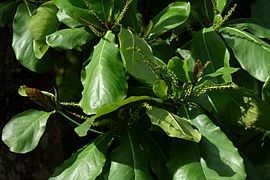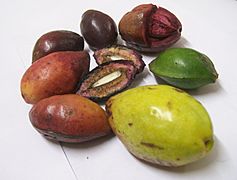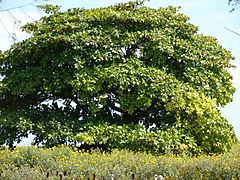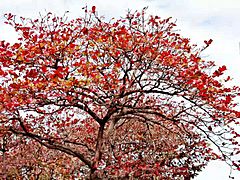Terminalia catappa facts for kids
Quick facts for kids Terminalia catappa |
|
|---|---|
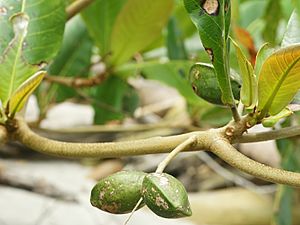 |
|
| Conservation status | |
| Scientific classification | |
| Genus: |
Terminalia
|
| Species: |
catappa
|
| Synonyms | |
|
List
|
|
The Terminalia catappa is a large tree that grows in warm, tropical places. It belongs to the leadwood tree family, called Combretaceae. You can find it mainly in tropical parts of Asia, Africa, and Australia.
People call this tree by many names. Some common English names are country almond, Indian almond, Malabar almond, sea almond, tropical almond, beach almond, and false kamani.
Contents
What Does the Tropical Almond Tree Look Like?
This tree can grow very tall, up to 35 meters (about 115 feet). When it's young, it has a neat, upright shape with branches that stick out straight. As the tree gets older, its top flattens out, looking more like a wide vase.
Its branches grow in clear, separate layers, which is a special feature. The leaves are big, about 15 to 25 cm (6-10 inches) long and 10 to 14 cm (4-5.5 inches) wide. They are shiny, dark green, and feel a bit like leather.
Seasonal Changes of the Leaves
The tropical almond tree loses its leaves during the dry season. Before they fall, they change color. They turn beautiful shades of pink, red, or yellow-brown. This color change happens because of natural colors inside the leaves, like violaxanthin and lutein.
Flowers and Fruit of the Tropical Almond
The trees have both male and female flowers on the same plant. This is called being monoecious. The flowers are small, about 1 cm (0.4 inches) across, and are white to greenish. They don't have petals and are not very noticeable. They grow in spikes along the branches.
The fruit is a type of fleshy fruit called a drupe, like a peach or a plum. It is about 5 to 7 cm (2-2.8 inches) long and 3 to 5.5 cm (1.2-2.2 inches) wide. When the fruit is young, it's green. Then it turns yellow, and when it's fully ripe, it becomes red. Each fruit holds one seed inside.
The fruit is light and can float on water. This helps the seeds travel to new places and grow new trees. The seed inside the ripe fruit is safe to eat and tastes a bit like an almond. The name catappa comes from its Malay name, Ketapang.
Where Does the Tropical Almond Tree Grow?
It's hard to say exactly where the tropical almond tree first came from. This is because people have moved it around the world for a very long time. It has grown naturally in many places, from Africa to northern Australia and New Guinea. It also grows across Southeast Asia, Micronesia, and the Indian subcontinent.
More recently, the tree has been brought to parts of North and South America. In Brazil, it was once popular for planting in cities. People liked that its leaves fell, making the streets look like European autumns. However, now, local evergreen trees are often planted instead.
How People Use the Tropical Almond Tree
The Terminalia catappa is grown in many tropical areas. People often plant it as an ornamental tree because its large leaves provide a lot of shade. The fruit is edible, but it has a slightly sour taste.
Uses of the Wood
The wood of the tropical almond tree is red and strong. It is also very good at resisting water. Because of this, people in Polynesia have used its wood to build canoes for a long time.
Medicinal Uses of the Leaves
The leaves of the tree contain many natural chemicals. These include things called flavonoids and tannins. Because of these chemicals, the leaves and bark are used in different herbal medicines.
For example, in Taiwan, fallen leaves are used as an herb to help with liver problems. In Suriname, people make a tea from the leaves to help with stomach issues like dysentery and diarrhea. Some studies suggest the leaves might have properties that help fight against certain diseases, but more research is needed.
Tropical Almond for Aquariums
Many fish breeders put tropical almond leaves in their aquariums. The leaves can help lower the water's pH level and reduce heavy metals. They are also believed to help prevent fungus from growing on fish eggs. The leaves may also help protect fish from some parasites and bacteria.
Gallery
-
A tropical almond tree canopy on Sand Island, Midway Atoll
- Terminalia catappa in West African plants – A Photo Guide.
See also
 In Spanish: Terminalia catappa para niños
In Spanish: Terminalia catappa para niños




